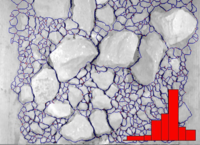Soil gradation

Soil gradation is like building a sandcastle at the beach. When you build your sandcastle, you need to use different sizes of sand to make it strong and sturdy. Soil gradation is similar in that soil needs to have different sizes of particles to make it strong and stable.
Think of soil particles like different colored balls. In soil, there are big balls (called gravel), medium-sized balls (called sand), small balls (called silt), and tiny balls (called clay). Just like building your sandcastle, if you only use one size of ball, it won't be very strong. But if you use all the different sizes of balls, it will be much stronger.
Soil gradation is the distribution of these different sizes of balls in the soil. A soil that has a good gradation will have a mix of many different sized particles, like a well-mixed batch of cookie dough. A soil that has poor gradation will have too many of one size of particle, like a cookie dough with too many chocolate chips and not enough dough.
So why does soil gradation matter? Well, soils with good gradation are better for building roads, bridges, buildings, and other structures because they are stronger and more stable. A soil with poor gradation can move around more easily and may not be able to support heavy things.
In summary, soil gradation is like building a sandcastle with different sizes of sand. Good gradation means a mix of different sized particles, which makes soil strong and stable for building things.
Think of soil particles like different colored balls. In soil, there are big balls (called gravel), medium-sized balls (called sand), small balls (called silt), and tiny balls (called clay). Just like building your sandcastle, if you only use one size of ball, it won't be very strong. But if you use all the different sizes of balls, it will be much stronger.
Soil gradation is the distribution of these different sizes of balls in the soil. A soil that has a good gradation will have a mix of many different sized particles, like a well-mixed batch of cookie dough. A soil that has poor gradation will have too many of one size of particle, like a cookie dough with too many chocolate chips and not enough dough.
So why does soil gradation matter? Well, soils with good gradation are better for building roads, bridges, buildings, and other structures because they are stronger and more stable. A soil with poor gradation can move around more easily and may not be able to support heavy things.
In summary, soil gradation is like building a sandcastle with different sizes of sand. Good gradation means a mix of different sized particles, which makes soil strong and stable for building things.
